News & Blogs
Hinamatsuri, also called Doll’s Day, celebrates girls’ happiness and healthy growth by displaying dolls called “Hina ningyo (雛人形)” dressed in ancient wedding costumes.
Hinamatsuri (雛祭り) is to wish girls’ happiness through dolls.
Amazing details and historical background of Hina dolls (雛人形 Hina ningyo).
Festive foods amplify the joy of the Hina doll festival.
In this blog, we touch on diverse topics about Japanese food cultures, practices together with the culinary secret, TREHA®, and its important role in the Japanese food industry. We hope our blog helps you obtain in-depth knowledge of the secrets and science behind Japanese cuisine, shared from our kitchen, to yours.
What is Hinamatsuri (雛祭り)?
Hinamatsuri, or Doll’s Day, is a traditional Japanese event celebrating girls’ happiness and healthy growth by displaying the dolls (雛人形 Hina ningyo) in national court dresses for the wedding ceremony. Although there are many theories about the origin of the Doll’s Festival, the "Joshi-no-Sekku (上巳の節句) introduced from ancient China is believed to be most realistic. The Joshi (上巳) means the first “day of the snake” in March based on the ancient Chinese astrology represented by 12 different animals. The date has been fixed on the 3rd of Mach since Wei Dynasty.
China developed a custom to have a banquet on this day after ablution. Japan also has a similar idea of ritual purification by washing from head to toe, called “Misogi (禊)” or by stroking the body using a human-shaped piece of tree or paper to transfer one's bad luck, and then flush away with flowing water. It is believed that ancient Chinese and indigenous Japanese customs were merged to develop the tradition of Joshi-no-sekku.
This seasonal event was also fused with paper dolls frequently played by the aristocracy’s children in Kyoto during the Heian period (end of the 8th century to the end of the 12th century). Over an extended period, a set of dolls, Hina ningyo, came to represent the wedding ceremony at the imperial court and eventually became a spiritual event. From the Edo period (17th century) onward, Hina dolls and their accessories became more ornate and grand, inspiring young girls with aesthetic features. Thus, the Joshi-no-Sekku festival, including displaying the dolls, developed into the grandeur "Hinamatsuri" festival.
On the other hand, some regions still practice the custom of "Nagashi-bina" (floating Hina dolls down the river or into the sea) based on the idea of transferring lousy luck to the paper dolls to be sent away with flowing water.
Until the mid-19th century, the "Joshi-no-Sekku" festival was held on March 3rd of the lunar calendar, which falls in April of today after the solar calendar was introduced in the Meiji period (1868-1912). It is also called "Momo no sekku" (桃の節句, Peach festival) because it is the time of year when peach blossoms bloom. While the Hina doll festival is generally celebrated on March 3rd of the Gregorian calendar, the cold regions with a lot of snowfall, such as the Tohoku and Hokuriku regions, postpone the celebration on April 3rd of the solar calendar.
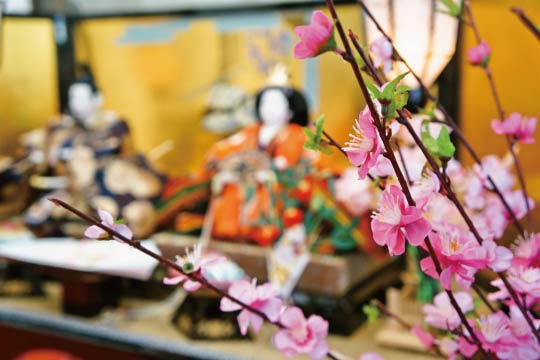
Hina dolls reveal their historical details.
As mentioned earlier, dolls are dressed in court costumes worn at weddings of the Heian period. The traditional way to decorate dolls is to display them on a staircase-like platform.
Although styles of display and dolls’ accessories vary by region, a typical doll decoration has seven tiers because the Japanese believe odd numbers bring luck.
Due to today’s Japanese housing situation, it is typical to display a compact version of doll sets such as five-tiered, three-tiered, and even single platform decorations with only the central figures, including the Emperor (obina) and the Empress (mebina).
The following figures represent the court wedding ceremony in a traditional set of Hina dolls.
The Emperor (Obina, commonly called as Odairi-sama お内裏様) and The Empress (Mebina, widely hailed as Ohina-sama お雛様) are the VIPs in this entire set.
Three court ladies (Sannin-kanjo 三人官女) are the maids who take after the Emperor and the Empress in their private quarters.
Five court musicians are performing Noh music. (Gonin-bayashi 五人囃子)
Two military officers armed with bows and arrows are called the minister of the left (Sadaijin左大臣) and the minister of the right (Udaijin 右大臣), who are protecting the Emperor and Empress. The dolls are paired with elder and young males. The older officer with a reddish and bearded face is placed on the left side of the Emperor, whereas the young, handsome officer is placed on the right side.
Three male figures placed at the lowest tire are servants called Sannin-jogo (三人上戸), or Sannin Shicho (三人仕丁) are the only commoners in the group, holding items necessary for their assigned chores. Each figure shows the facial expression of anger, tears, and laughter, designed to accentuate the doll set by adding some emotions.
Dolls’ accessories consist of Japanese paper lanterns, the bride's household articles (furniture, wardrobes, hibachi heaters, vehicles, tea ceremony items, and tiered storage boxes), cherry blossom, and Tachibana citrus trees.
The Emperor doll is usually placed on the left, with the Empress doll on the right from viewers. The layout used to be the other way around because the Emperor historically has been sitting on the “superior” position (east side) where the sun rises from the location of the Kyoto Imperial Palace. It is said that this position was changed when Emperor Showa ascended to the throne in 1928 to be consistent with official standing positions used by other monarchies of the world.
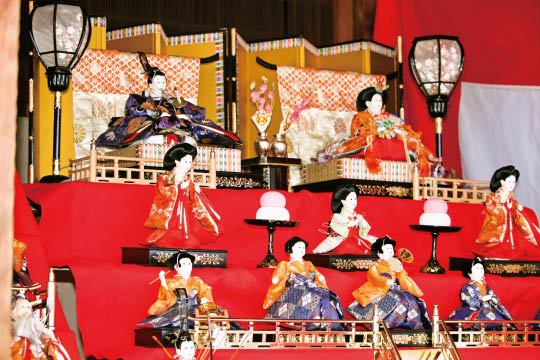
Hinamatsuri accompanies festive foods.
The Doll’s festival is also a day to celebrate ongoing good health conditions and welcome spring while wishing the family prosperity. As we've already mentioned, the Japanese prepare special foods at traditional events and celebrations. Here are some of the most common specialty foods for the Doll’s Festival.
Diamond-shaped mochi (Hishi mochi 菱餅):
Diamond-shaped mochi is in three tiers which are colored green, white, or red from the bottom, indicating wishes for the girl’s healthy growth represented by color. Red (or pink) mochi contains the red pigment from gardenia fruit, detoxifying properties. The color red is believed to ward off evil. White mochi contains the seeds of the water caltrop, which is known to have a medicinal effect in lowering blood pressure. White is the color associated with prosperity, longevity, and purity. Green mochi contains Japanese mugwort with a bold herbal scent to ward off evils. Green also represents the vitality of plants thriving under snow.

Pastel-toned rice crackers (Hina-arare 雛あられ):
These lovely rice crackers used to be picnic snacks consumed during the excursion with Hina dolls. There was a custom to bring out Hina dolls outside, a spring field trip for girls, and Hina dolls to appreciate natural scenery like plains, mountains, and beaches in the Edo period. While the sweet pastel colors of the crackers indicate the wish for girls to be happy throughout the four seasons, the taste and shape of the crackers vary depending on the region. In the Kansai (Greater Osaka) region, Hina cracker is savory deep-fried rice cake bits, whereas it is sweetened puffed rice in the Kanto (Greater Tokyo) region.
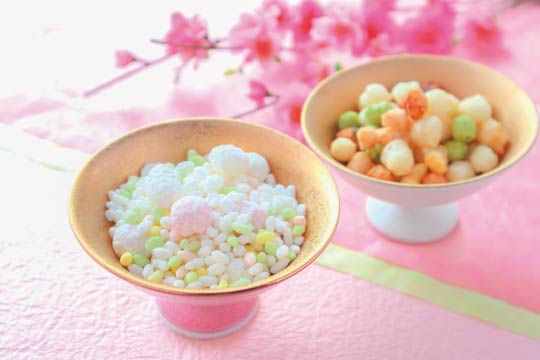
White sake (Shirozake 白酒 ):
During the celebration, sake infused with peach blossoms were historically consumed because the pronunciation of peaches sounds similar to “centennial” in Japanese. Today, white sake is a sweet low alcoholic sake made of purred koji rice and steamed glutinous fermented in mirin (sweet sake) or shochu (distilled spirit) for a month. Children’s alternatives are non-alcoholic amazake (fermented sweet rice drink) or juice.
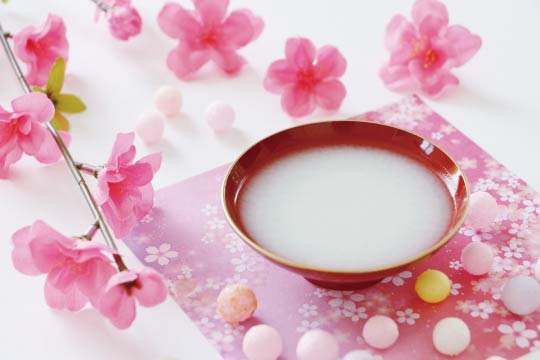
Scattered sushi (Chirashi-sushi ちらし寿司):
For the Hinamatsuri festival, gorgeous Chirashi-sushi is prepared using colorful toppings such as red prawns, white lotus root, and green beans to amplify the festivity in spring.
As mentioned in the previous post on the Osechi ryori (New Year's festive food), such food items bring luck; prawns for longevity, lotus root for good prospects, and beans for vitality and health to achieve success.
Clam clear soup (Hamaguri-no-ushiojiru 蛤の潮汁):
A clear soup with clams is often served with Chirashi-sushi. Clams are considered a symbol of stable partnership because identical-shaped pairs of shells are hinged together, not allowing substitute shells. The clam indicates girls’ life-long partnership with suited significant others.
What kind of course meal can you think of to celebrate the Hina doll festival?
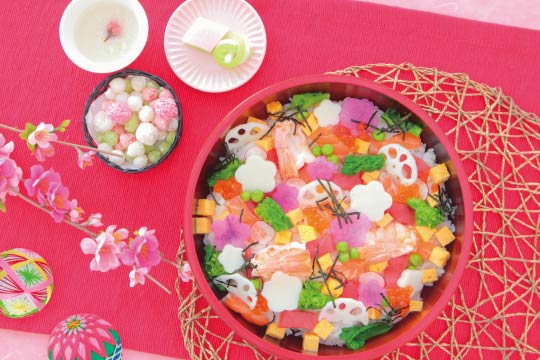
Did you find this blog interesting?
Please share it with your friends in the food service industry.
We regularly update the blog about the food culture of Japan, where TREHA® was discovered for culinary applications.
Click here and send us a message to subscribe.
Or hit us up on Instagram @trehalose_sensei!
You might also be interested in:
Japanese traditional food series 2: Chitose Ame, candy for healthy longevity (千歳飴)
Japanese traditional food series 3: Yuzu (柚子) and the winter solstice
Japanese traditional food series 4: Noodles on New Year's Eve (年越しそば)
Japanese traditional food series 5: Japanese traditional New Year’s dishes, Osechi-ryori (おせち料理)
Japanese traditional food series 6: Another traditional food for New Year’s celebration, mochi (餅)
Japanese traditional food series 13: Inari sushi offered to a deity of harvests

